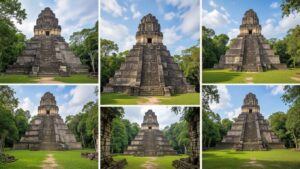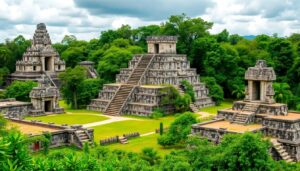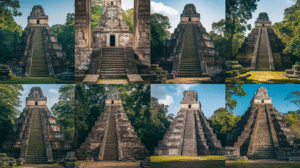Belize is renowned as the home of the highest concentration of ancient Maya archaeological sites in Central America, boasting an astonishing catalog of over 1,400 documented locations that reflect a rich history spanning more than three thousand years. From the magnificent riverbank temples at Lamanai to the towering pyramids of Caracol, each archaeological site provides invaluable insights into the intricate aspects of Maya governance, spirituality, and the everyday lives of the Maya people. This extensive guide aims to highlight the nine essential ruins that should be included in your itinerary, offer practical travel tips, and present the cultural context needed for a deeply immersive experience of Belize’s archaeological treasures.
Explore Why Belize Represents the Epicenter of Ancient Maya Civilization
The emergence of the Maya civilization in what is now Belize dates back to at least 2000 BCE, thriving extensively until well into the colonial period imposed by the Spanish. The prosperity of this remarkable civilization was largely supported by the fertile river valleys, especially along the New River and Belize River, as well as the abundant marine resources provided by the nearby world’s second-largest barrier reef. Furthermore, a complex system of trade routes and political alliances fortified their economic stability. Today, the Institute of Archaeology, under the auspices of the National Institute of Culture and History (NICH), manages 14 official archaeological reserves. Many of these reserves are located within or close to UNESCO World Heritage sites. Their ongoing efforts, along with decades of scholarly research, illuminate the profound impact of Belizean Maya communities on regional history.
Unlock the Secrets of the 9 Essential Maya Ruins in Belize for an Extraordinary Experience
Uncover the Maritime Trading Centers of Northern Belize
Experience Lamanai: “Submerged Crocodile” – The Longest Continuously Inhabited Maya Site
Lamanai, derived from the Yucatec Maya word Lama’anayin, meaning “submerged crocodile,” is strategically positioned along the banks of the New River Lagoon and has a remarkable history of habitation that spans from the 16th century BCE to the mid-20th century CE. This site served not only as a crucial trade nexus but also forged essential connections between inland communities and coastal merchants. Visitors typically embark on a boat ride from Tower Hill to reach this stunning location, where they can marvel at the impressive Mask Temple, showcasing a striking 2.7-meter stucco mask of the rain deity. Additionally, the Jaguar Temple and the High Temple rise prominently above the surrounding lush jungle canopy, offering breathtaking views. Ongoing archaeological excavations led by NICH reveal residential courtyards, a ball court, and substantial evidence of trade involving jade, obsidian, and ceramics (Institute of Archaeology, NICH).
Discover Altun Ha: “Rockstone Water” – The Site of the Famous Jade Head Discovery
Located approximately 50 kilometers north of Belize City, Altun Ha, which translates to “rock water,” gained international fame in 1968 when archaeologists from the Royal Ontario Museum unearthed the stunning 4.42 kg jade head of Kinich Ahau. This remarkable artifact is recognized as the largest carved jade object from the Maya civilization and is currently housed at the Museum of Belize (Royal Ontario Museum). The site is dominated by the 16-meter-tall Temple of the Masonry Altars, which offers a commanding view over ancient trade routes that historically linked inland polities to Caribbean ports. Interestingly, unlike many other Classic-period centers, Altun Ha lacks inscribed stelae, suggesting that its elite favored monumental sculptures over hieroglyphic inscriptions (Pendergast 1979).

Uncover Santa Rita: A Site Illustrating Late-Period Cultural Interactions
Situated near Corozal Town, the Santa Rita site remained a vibrant Maya settlement well into the early colonial period. Artifacts unearthed here, including ceramics along with Spanish-era items, document the adaptability of the Maya in response to European contact and influences. Additionally, the nearby Cerros site, linked by a network of causeways, highlights the economic resilience and evolving trade networks of northern Belize during this transitional period (Awe 2005).
Explore the Influential Political Centers of Western Belize (Cayo District)
Experience Xunantunich: The “Stone Lady” Legend and the Majestic El Castillo Pyramid
Perched on a scenic bluff overlooking the Mopan River, Xunantunich, meaning “Stone Lady” in the Mopan Maya language, features the iconic El Castillo pyramid, which rises to an impressive height of 43 meters. To access the site, visitors must first cross the river using a hand-cranked ferry before ascending through the jungle. Upon arrival, they can admire an astronomical frieze that depicts the cycles of the sun god and Venus. Local folklore speaks of a spectral figure, often described as a white-robed spirit, seen atop the central plaza, adding an intriguing element of mystery to this historical site (Chase & Chase 2015).
Discover Caracol: The “Snail” – The Largest and Most Powerful Maya Site in Belize
Covering an expansive area of over 200 square kilometers, Caracol reached its peak around 650 CE, supporting an impressive population of approximately 120,000 inhabitants, positioning it as a significant competitor to Tikal in terms of political power and scale. The site’s Caana (“Sky Place”) temple ascends to a towering height of 43 meters, making it the tallest man-made structure in Belize. Throughout the site, over 120 carved stelae narrate dynastic victories, including the notable conquest of Caracol over Tikal in 562 CE, while inscriptions provide invaluable insights into the political framework and governance of the Maya civilization (Chase & Chase 1996). Additionally, advanced agricultural techniques and hydraulic systems highlight the sophisticated urban planning that characterized Caracol.
Visit Cahal Pech: “Place of Ticks” – An Early Royal Acropolis Complex
Cahal Pech, meaning “place of ticks” in Yucatec Maya, is located on a ridge that overlooks San Ignacio. As one of the earliest civic-ceremonial centers in Belize, dating back to around 1200 BCE, the site features limestone palaces and ballcourts that exemplify early Maya architectural styles. Its proximity to the town makes it a convenient destination for families and visitors eager to gain an insightful introduction to the rich history of Maya ruins (Powis et al. 2010).
Venture Through Southern Belize – Discover the Unique Architectural Styles of the Maya
Explore Lubaantun: “Place of Fallen Stones” – Renowned for Its Unique Mortarless Construction Techniques
Nestled within the misty hills of the Toledo District, Lubaantun is notable for its unique black slate masonry, constructed without mortar using ingenious “in-and-out” techniques, which gives it a distinctive stepped appearance. The site encompasses three ballcourts and numerous burial caches that indicate its significant ritual importance. Additionally, it is here that the infamous crystal skull reportedly emerged in 1924, although scholars continue to debate its authenticity and origins (Mitchell-Hedges 1998).
Discover Nim Li Punit: “Big Hat” – Home to the Tallest Stela in Belize
Located in the Toledo region, Nim Li Punit is home to 26 intricately carved stelae, with the most notable being Belize’s tallest monument, depicting a king adorned with an extravagant “big hat.” The stelae plaza is believed to have functioned as an astronomical observatory, marking significant equinox alignments, thereby reflecting the Maya's advanced understanding of astronomy and their connection to celestial events (Helmke & Awe 2016).

Investigate Uxbenka: Recent Excavations Reveal Astronomical Alignments
Since 2015, excavations at Uxbenka have revealed temple platforms meticulously aligned with the points of the solstice sunrise, highlighting the remarkable astronomical knowledge possessed by the Maya. Situated near the Guatemalan border, this rural site offers pristine opportunities for exploration and provides valuable insights into the political dynamics of Classic-period southern Maya societies (Smithsonian Mesoamerican Research).
Key Considerations for Planning Your Unforgettable Adventure to the Maya Ruins
Transportation & Access:
Reaching most Maya sites requires ground transportation. From Belize City, daily bus services or private shuttles provide transport to San Ignacio and Corozal; from these hubs, various tour operators offer 4×4 excursions to the sites. Notably, accessing Caracol necessitates a 16 km drive on unpaved roads that can often become impassable during heavy rains, especially from June to October. Domestic flights are available from Belize City’s Philip S.W. Goldson Airport to San Pedro and Dangriga, but these flights do not service inland archaeological sites.
Entry Fees & Guides:
All NICH-managed reserves enforce official entry fees ranging from USD 12 to 25. For additional information, visit the Belize Tourism Board. Hiring licensed guides can significantly enhance your experience as they provide expert interpretations of hieroglyphs, architectural features, and the ecological context of the sites. It is essential to note that research permits are stringently enforced for academic projects.
Best Time to Visit:
The ideal time to explore the sites is during the dry season, from November to April, which typically offers sunny days, manageable humidity levels, and optimal conditions for photography. It is advisable to avoid peak holiday periods, such as Christmas to New Year, when local resorts are often fully booked. Additionally, the shoulder months of May and October may offer lower rates and moderate rainfall.
What to Bring:
Visitors should prepare for their adventures by bringing sun protection, which includes a wide-brimmed hat and reef-safe sunscreen, along with long-sleeved shirts to guard against insects. Sturdy hiking shoes are essential for navigating the rugged terrain, and it’s prudent to pack water, electrolyte-rich snacks, and extra camera batteries. A lightweight rain jacket can also be invaluable in the event of sudden tropical downpours.
Enhance Your Knowledge of Maya Civilization Through Their Remarkable Ruins
During the Classic Period (250–900 CE), the Maya civilization achieved extraordinary advancements, including the refinement of hieroglyphic writing, which remains the longest pre-Columbian script in the Americas. They also conceptualized the concept of zero within their vigesimal number system. The orientations of temples throughout Belize reveal intricate connections to solar and Venus-cycle observations, which were vital for their ritual calendars. Extensive riverine trade networks facilitated the exchange of jade, obsidian, cacao, and salted fish between coastal and highland polities, forging essential economic interdependencies across Mesoamerica (Helmke & Awe 2016).
Emphasizing the Importance of Conservation and Respecting Cultural Heritage
The Institute of Archaeology (IA-NICH) in Belize has implemented a strict permit system for both research and tourism activities, overseeing 14 archaeological reserves. To minimize wear on delicate limestone structures, visitor limits are enforced during peak midday hours, and entrance fees directly support the preservation efforts of these invaluable sites. Local guide programs ensure that income generated through tourism benefits the Maya communities directly. Furthermore, photography restrictions, such as prohibiting flash in mural-rich chambers and forbidding climbing on fragile structures, are in place to ensure the preservation of these invaluable sites for future generations.

Examine the Resilience of Contemporary Maya Communities and Their Cultural Continuity
Today, the Maya communities residing in Toledo persist in upholding traditional milpa agroforestry systems that involve rotating crops such as corn, beans, and squash, mirroring ancient agricultural practices. Moreover, community-based tourism initiatives along the Toledo Maya Cultural Route provide authentic homestays and traditional cooking experiences, effectively linking the preservation of heritage with economic empowerment for local populations (Belize Maya Forest Trust).
Delve into the Comprehensive Bibliography for Further Reading
-
Institute of Archaeology, NICH. “Protected Archaeological Sites.” https://nichbelize.org
-
Royal Ontario Museum. “Altun Ha Excavations.” https://rom.on.ca
-
Pendergast, David. Altun Ha: Jade Head Discovery and Context. Museum of Belize, 1979.
-
Awe, Jaime. Archaeological Research in Corozal and Santa Rita. Northern Arizona University Press, 2005.
-
Chase, Arlen & Diane. Xunantunich and Caracol: Temple Sites of Western Belize. UNLV Reports, 2015.
-
Chase, Arlen & Diane. Caracol Archaeological Project Reports. UNLV Reports, 1996.
-
Powis, Terry et al. “Cahal Pech Excavations and Regional Role.” Journal of Maya Studies 12, no. 2 (2010).
-
Mitchell-Hedges, Anna. Mysteries of the Crystal Skull. London: Explorer’s Press, 1998.
-
Helmke, Christophe & Jaime Awe. “Ancient Maya Territorial Organization and Astronomy.” Mesoamerican Research Journal 22, no. 1 (2016).
-
Smithsonian Institution. “Uxbenka Archaeological Project.” Mesoamerican Research, 2021.
-
Belize Maya Forest Trust. “Community-Based Cultural Route.” https://belizemayaforest.org
The Article Ancient Maya Ruins in Belize: Complete Guide to 9 Archaeological Treasures appeared first on Belize Travel Guide
The Article Ancient Maya Ruins: Your Complete Guide to Belize’s Treasures Was Found On https://limitsofstrategy.com
The Article Ancient Maya Ruins: Explore Belize’s Hidden Treasures First Appeared ON
: https://ad4sc.com





No responses yet